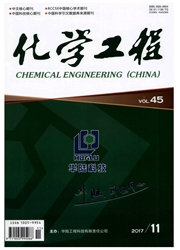

 中文摘要:
中文摘要:
为了掌握CO变换催化剂在高炉煤气气氛下的中毒机理,文中采用热力学非均相反应体系中的Gibbs自由能最小原理,从理论上分析了CO变换催化剂在高炉煤气气氛下,HCN中毒可能发生的化学反应及产物。对各个反应的吉布斯自由能及化学反应平衡常数进行了对比分析,结果表明:氰化氢(HCN)对于铁基高温变换催化剂在其活性温度下的中毒作用很小,而对于铜基低温变换催化剂在100—300℃的活性温度下,主要的中毒产物为CuCN,CuO,Cu2O,Cu(OH)2,C,且高炉煤气自身的主要气体混合也是使催化剂中毒的原因之一。此外,氧气的存在会加快催化剂的中毒反应。其中低温变换催化剂的活性物质Cu微晶与CO和O2反应的吉布斯自由能小于0,且绝对值最大,热力学平衡常数最大。这个反应是竞争能力最强的主导反应。
 英文摘要:
英文摘要:
In order to grasp the CO shift catalyst in an atmosphere of blast furnace gas poisoning mechanism, based on the advantage of the minimum of Gibbs free energy of heterogeneous reaction system in thermodynamics, the probable chemical reactions and products from hydrogen cyanide (HCN) poisoning of CO shift catalyst in the blast furnace gas atmosphere were analyzed. By comparing Gibbs free energy and chemical reaction equilibrium constant of each reaction, it concludes that the poisoning effect of HCN on the iron-based high temperature shift catalyst at its activity temperature is very small. For copper-based low temperature shift catalyst at its activity temperature of 100-300 °C, the main toxic products are CuCN, CuO, Cu20, Cu(OH)2, C, and the part of blast furnace gas is also one of the reasons to make catalyst poisoning. The catalyst poisoning could be speeded up due to the existence of oxygen. The Gibbs free energy of the reaction of Cu-ceramie material ( active material of low temperature shift catalyst) with CO and 02 is less than zero, the Gibbs free energy has the maximum absolute value, and the thermodynamic equilibrium of this reaction is the largest. This reaction is the dominant one that has the strong competition.
 同期刊论文项目
同期刊论文项目
 同项目期刊论文
同项目期刊论文
 Adsorption/desorption of low concentration of carbonyl sulfide by impregnated activated carbon under
Adsorption/desorption of low concentration of carbonyl sulfide by impregnated activated carbon under Adsorption of carbon disulfide on activated carbon modified by Cu and cobalt sulfonated phthalocyani
Adsorption of carbon disulfide on activated carbon modified by Cu and cobalt sulfonated phthalocyani Energy Utilization of Yellow Phosphorus Tail Gas:Simultaneous Catalytic Hydrolysis of Carbonyl Sulfi
Energy Utilization of Yellow Phosphorus Tail Gas:Simultaneous Catalytic Hydrolysis of Carbonyl Sulfi Activity and hydrothermal stability of CeO2–ZrO2–WO3 for the selective catalytic reduction of NOx wi
Activity and hydrothermal stability of CeO2–ZrO2–WO3 for the selective catalytic reduction of NOx wi Rapid Determination of Ethyl Laurate from Supercritical Ethanol?Carbon Dioxide Transesterification b
Rapid Determination of Ethyl Laurate from Supercritical Ethanol?Carbon Dioxide Transesterification b Selective catalytic reduction of NO with NH3 over CeO2–ZrO2–WO3 catalysts prepared by different meth
Selective catalytic reduction of NO with NH3 over CeO2–ZrO2–WO3 catalysts prepared by different meth Novel promoting effect of acid modification on selective catalytic reduction of NO with ammonia over
Novel promoting effect of acid modification on selective catalytic reduction of NO with ammonia over Simultaneous catalytic hydrolysis of carbonyl sulfide and carbon disulfide over Al2O3-K/CAC catalyst
Simultaneous catalytic hydrolysis of carbonyl sulfide and carbon disulfide over Al2O3-K/CAC catalyst Simultaneous catalytic hydrolysis of low concentration of carbonyl sulfide and carbon disulfide by i
Simultaneous catalytic hydrolysis of low concentration of carbonyl sulfide and carbon disulfide by i Enhanced performance in NOx reduction by NH3 over a mesoporous Ce–Ti–MoOx catalyst stabilized by a c
Enhanced performance in NOx reduction by NH3 over a mesoporous Ce–Ti–MoOx catalyst stabilized by a c Adsorption of Carbon Disulfide on Cu/CoSPc/Ce Modified Activated Carbon under Microtherm and Micro-o
Adsorption of Carbon Disulfide on Cu/CoSPc/Ce Modified Activated Carbon under Microtherm and Micro-o A novel and environmentally friendly SO42?/CeO2 catalyst for the selective catalytic reduction of NO
A novel and environmentally friendly SO42?/CeO2 catalyst for the selective catalytic reduction of NO 期刊信息
期刊信息
